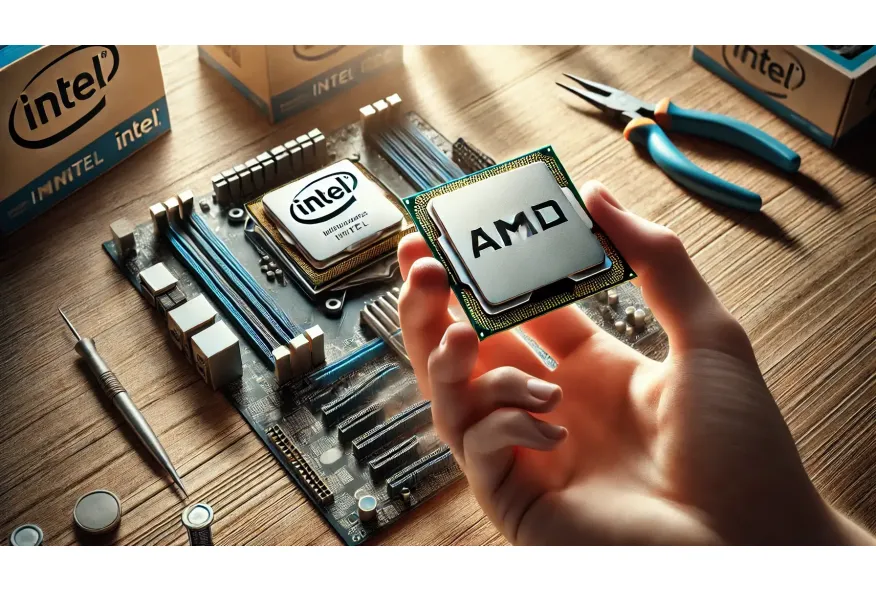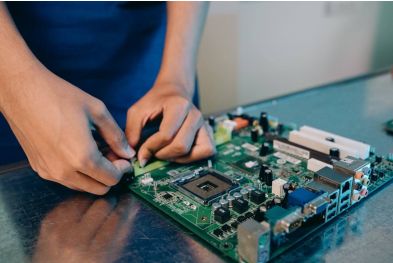How to Choose the Best Processor: Intel vs. AMD
The processor (CPU) is the brain of your computer, handling all calculations and tasks. Choosing the right CPU is essential for gaming, content creation, programming, and everyday use.
Intel and AMD are the two leading CPU manufacturers, each offering processors with different features, performance levels, and pricing. In this guide, we’ll compare Intel and AMD CPUs and help you pick the best one for your needs.
1. Understanding CPU Basics
Before choosing a CPU, it’s important to understand the key specifications that impact performance:
1.1 Core Count and Threads
- Cores: The number of physical processing units inside the CPU. More cores help with multitasking and demanding applications.
- Threads: Virtual cores that improve efficiency using Simultaneous Multithreading (SMT) or Hyper-Threading.
| Use Case | Recommended Cores/Threads |
|---|---|
| Basic tasks (web browsing, office work) | 4 Cores / 8 Threads |
| Gaming | 6-8 Cores / 12-16 Threads |
| Streaming & Content Creation | 8-16 Cores / 16-32 Threads |
| Professional Work (3D rendering, AI, video editing) | 12+ Cores / 24+ Threads |
1.2 Clock Speed (GHz)
Measured in gigahertz (GHz), clock speed determines how fast the CPU executes tasks. A higher GHz generally means better performance.
- Base Clock: The default speed of the CPU.
- Boost Clock: The maximum speed the CPU can reach under load.
1.3 Cache (L1, L2, L3)
Cache is a small, fast memory inside the CPU that stores frequently used data. A larger cache improves performance.
1.4 TDP (Thermal Design Power)
TDP measures the CPU’s power consumption and heat output. Higher TDP means more heat and requires better cooling.
2. Intel vs. AMD: Key Differences
Both Intel and AMD offer great CPUs, but they have different strengths.
| Feature | Intel | AMD |
|---|---|---|
| Performance per Core | Stronger single-core performance | Strong multi-core performance |
| Overclocking | Only on unlocked (K-series) CPUs | Most Ryzen CPUs support overclocking |
| Integrated Graphics | Most Intel CPUs have integrated graphics | Only Ryzen "G" series has integrated graphics |
| Power Efficiency | Generally runs cooler, lower power draw | Higher core count, higher power draw |
| Best for Gaming | High single-core performance benefits games | Competitive in multi-core-heavy games |
| Best for Productivity | Good for professional workloads | More cores at a lower price, better for rendering & streaming |
3. Intel Processors Explained
Intel’s latest CPUs use the Intel Core i3, i5, i7, and i9 naming scheme.
| Series | Best Use Case | Example CPUs |
|---|---|---|
| Core i3 | Budget PCs, office work, light gaming | i3-13100, i3-12100 |
| Core i5 | Mid-range gaming, productivity | i5-13600K, i5-12400F |
| Core i7 | High-end gaming, content creation | i7-13700K, i7-12700K |
| Core i9 | Professional work, extreme gaming | i9-13900K, i9-12900KS |
Intel Strengths:
✅ Great for gaming due to high clock speeds and strong single-core performance.
✅ Efficient power usage in lower-end models.
✅ Integrated graphics on most models (useful if you don’t have a dedicated GPU).
✅ Best compatibility with DDR5 memory on newer chipsets.
Intel Weaknesses:
❌ Only K-series CPUs (e.g., i5-13600K, i7-13700K) support overclocking.
❌ Often more expensive than AMD alternatives.
4. AMD Processors Explained
AMD uses the Ryzen 3, 5, 7, and 9 naming scheme.
| Series | Best Use Case | Example CPUs |
|---|---|---|
| Ryzen 3 | Budget PCs, office work, light gaming | Ryzen 3 5300G, Ryzen 3 4100 |
| Ryzen 5 | Mid-range gaming, productivity | Ryzen 5 7600X, Ryzen 5 5600X |
| Ryzen 7 | High-end gaming, streaming, content creation | Ryzen 7 7800X3D, Ryzen 7 5700X |
| Ryzen 9 | Professional workloads, extreme gaming | Ryzen 9 7950X, Ryzen 9 5900X |
AMD Strengths:
✅ More cores and threads for the price, great for multitasking.
✅ Unlocked CPUs for overclocking.
✅ Best performance in productivity and rendering tasks (video editing, 3D modeling).
✅ Longer motherboard support (AM4 lasted for years, AM5 expected to be supported long-term).
AMD Weaknesses:
❌ Ryzen CPUs require a dedicated GPU, except for Ryzen "G" series.
❌ Higher-end models consume more power and require better cooling.
5. Gaming Performance: Intel vs. AMD
Intel and AMD both offer great gaming CPUs, but Intel often has better single-core performance, which benefits games.
For 1080p gaming, Intel’s Core i5-13600K and AMD’s Ryzen 7 7800X3D are some of the best choices.
For 1440p and 4K gaming, the GPU becomes more important, making high-core count CPUs like Intel i7-13700K and Ryzen 9 7950X a better choice.
Best CPUs for Gaming (2024)
- Budget: Ryzen 5 5600X / Intel i5-12400F
- Mid-Range: Ryzen 7 7800X3D / Intel i5-13600K
- High-End: Ryzen 9 7950X3D / Intel i9-13900K
6. Productivity and Content Creation
For professional tasks like video editing, 3D rendering, and software development, AMD’s higher core count makes it a better value.
| Task | Best CPU |
|---|---|
| Video Editing | Ryzen 9 7950X, Intel i9-13900K |
| 3D Rendering | Ryzen 9 7950X, Intel i9-13900KS |
| Streaming | Ryzen 7 7800X3D, Intel i7-13700K |
| Programming | Ryzen 5 7600X, Intel i5-13600K |
7. Price-to-Performance: Which One Should You Buy?
| Budget | Best Intel CPU | Best AMD CPU |
|---|---|---|
| Entry-Level (~$100-$150) | i3-13100 | Ryzen 5 4500 |
| Mid-Range (~$200-$300) | i5-13600K | Ryzen 5 7600X |
| High-End (~$400-$600) | i7-13700K | Ryzen 7 7800X3D |
| Extreme (~$600+) | i9-13900KS | Ryzen 9 7950X |
Final Thoughts
- For gaming, Intel often has a slight edge due to better single-core speeds.
- For content creation and productivity, AMD offers more cores for the price.
- For budget builds, both Intel and AMD have great options.
If you want a CPU that will last for years and allow future upgrades, AMD’s AM5 platform is a solid choice. If you prefer high clock speeds and strong out-of-the-box performance, go for Intel.
Whichever you choose, make sure it’s compatible with your motherboard and cooling system for the best experience. 🚀







